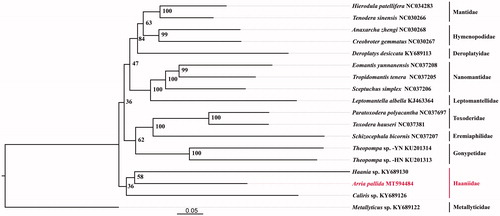Abstract
The complete mitochondrial genome of Arria pallida is 16,240 bp in length, containing 13 protein-coding genes (PCGs), 2 ribosomal RNA (rRNAs), a control region (D-loop), and 22 transfer RNA (tRNAs). The phylogenetic analysis included 18 species within 10 families of Mantodea using maximum likelihood (ML) method. The result showed that A. pallida is sister to Haania sp., both of which form a sister clade with Caliris sp.
Mantodea (praying mantis) is a group of camouflaged and predatory insects, encompassing about 2500 species (Wieland and Svenson Citation2018). Arria pallida (Zhang Citation1987) belongs to Arrini within Haaniidae. Arrini is a clade of oriental praying mantis (Schwarz and Roy Citation2018, Citation2019) and it is a rare tribe with few reports. Herein, the first complete mitochondrial genome of Arria pallida and its phylogenetic relationship with other Mantises is provided. This represents the first publish genomic data of Arrini.
The A. pallida sample was collected from Fanjingshan Nature Reserve (108.65°N, 27.91°E), Guizhou province, southwest of China, during August 2018. The specimen was stored in absolute ethanol and kept in the Institute of Entomology, Guizhou University (voucher no. Ha.A-201808fj01), Guiyang, China (IEGU). Sequencing was conducted using the Illumina HiSeq platform (San Diego, CA, USA). All the genes were predicted using MitoZ (Meng et al. Citation2019).
The complete mitochondrial genome of A. pallida (GenBank accession MT594484, link: https://www.ncbi.nlm.nih.gov/nuccore/MT594484) is 16,240 bp in length, with base composition: 40.2% A, 38.0% T, 13.1% C, and 8.7% G. Containing 13 PCGs, two rRNA genes, a putative control region (D-loop), and 22 tRNA genes. The N-strand codes nine PCGs (nd2, co1, co2, atp8, atp6, co3, nd3, nd6, and cytb), while the J-strand codes the remaining four PCGs (nd5, nd4, nd4l, and nd1). The gene arrangement of A. pallida is similar to the common type of putative ancestor of insects. Five start codons of PCGs exist: ATG (nad2, cox2, atp6, cox3, nad5, nad4, nad4l, and cytb), TTG (cox1), ATC (nad3), ATT (nad6), ATA (atp8 and nad1). Most of the 13 PCGs had TAA as stop codon whereas cox2, cox3 had T and nad5 had TA. The rrnL is 1320 bp (81.3% AT) and the rrnS is 786 bp (79.4% AT).
Phylogenetic analysis () was constructed using ML method with 13 PCG sequences extracted from 18 species within 10 families using IQtree version 1.6.12 (Nguyen et al. Citation2015). Metallyticidae was set as outgroup. Arria pallida was found to cluster with Haania sp., both of which form a sister clade with Caliris sp. This finding is consistent with the classification system set up by Schwarz and Roy (Citation2019).
Disclosure statement
No potential conflict of interest was reported by the author(s). The authors are responsible for the content and writing of the article.
Additional information
Funding
References
- Meng G, Li Y, Yang C, Liu S. 2019. MitoZ: a toolkit for animal mitochondrial genome assembly, annotation and visualization. Nucleic Acids Res. 47(11):e63–e63.
- Nguyen LT, Schmidt HA, von Haeseler A, Minh BQ. 2015. IQ-TREE: a fast and effective stochastic algorithm for estimating maximum-likelihood phylogenies. Mol Biol Evol. 32(1):268–274.
- Schwarz CJ, Roy R. 2018. Some taxonomic and nomenclatural changes in Mantodea (Insecta: Dictyoptera). Bull Soc Entomol Fr. 123(4):451–460.
- Schwarz CJ, Roy R. 2019. The systematics of Mantodea revisited: an updated classification incorporating multiple data sources (Insecta: Dictyoptera). Ann Soc Entomole France (NS). 55(2):101–196.
- Wieland F, Svenson GJ. 2018. Biodiversity of Mantodea. Insect Biodivers Sci Soc. 2:389–416.
- Zhang GZ. 1987. A new species of the genus Palaeothespis Tinkham from China (Mantidae: Thespinae). Entomotaxonomia. 3(9):239–241.

